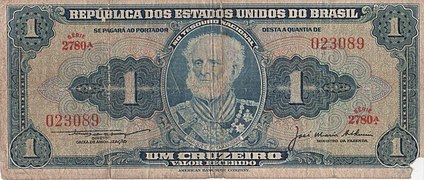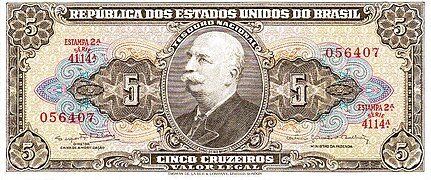The cruzeiro was the currency of Brazil between 1942 and 1967. It was the first currency to replace the old real (pl. réis), which had been in use since colonial times. It is consequently also the first Brazilian currency to implement fractional units called centavos. Additionally, it is the first of the 3 historical Brazilian currencies called "cruzeiro".
 Example of a 5 cruzeiro note from 1963, portraying the bust of Barão do Rio Branco on the obverse | |
| Unit | |
|---|---|
| Plural | cruzeiros |
| Symbol | ₢ or Cr$ |
| Denominations | |
| Subunit | |
| 1⁄100 | centavo |
| Plural | |
| centavo | centavos |
| Banknotes | ₢1, ₢2, ₢5, ₢10, ₢20, ₢50, ₢100, ₢200, ₢500, ₢1,000, ₢5,000, ₢10,000 |
| Coins | 10¢, 20¢, 50¢ ₢1, ₢2, ₢10, ₢20, ₢50 |
| Demographics | |
| Date of introduction | 1 November 1942[1] |
| Replaced | Real |
| Date of withdrawal | 13 February 1967[2] |
| Replaced by | Cruzeiro novo |
| User(s) | Brazil |
The cruzeiro replaced the real on 1 November 1942 at a rate of 1000 réis = 1 cruzeiro. It was replaced by the cruzeiro novo on 13 February 1967 at a rate of 1000 cruzeiros = 1 cruzeiro novo.
History
Coins
Six denominations of coins were introduced in 1942: 10, 20 and 50 centavos, and 1, 2 and 5 cruzeiros. The centavos were initially struck in cupronickel, switching to aluminium bronze in 1943, whilst the cruzeiros were struck in aluminium bronze from the start. The ₢5 was not struck after 1943.
| Reverse | Obverse | Value | Minting period | Obverse description |
|---|---|---|---|---|
 | 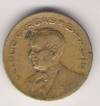 | ₢0.10 | 1942–1947 | Portrays Getúlio Vargas |
 |  | ₢0.20 | 1942–1948 | |
 |  | ₢0.50 | 1942–1947 | |
 | 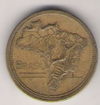 | ₢1 | 1942-1956 | Portrays a relief map of Brazil |
 |  | ₢2 | ||
 |  | ₢5 | 1942–1943 |
Following the end of the Vargas Era, in 1947 and 1948 replacements for the 10¢, 20¢ and 50¢ coins were issued that did not portray Getúlio Vargas on the obverse. The new designs featured busts of proeminent Brazilian people, along with the new president, Dutra.
| Reverse | Obverse | Value | Minting period | Obverse description |
|---|---|---|---|---|
 |  | ₢0.10 | 1947–1955 | Portrays José Bonifácio |
 |  | ₢0.20 | 1948–1956 | Portrays Ruy Barbosa |
 | 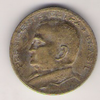 | ₢0.50 | 1948–1956 | Portrays Eurico Gaspar Dutra |
A few more designs were later introduced in 1956 and 1957, which eventually made aluminium replace aluminium bronze in all the coins.
| Reverse | Obverse | Value | Minting period | Obverse description |
|---|---|---|---|---|
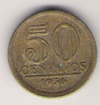 | 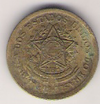 | ₢0.50 | 1956 | Portrays the coat of arms of Brazil |
 | 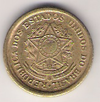 | ₢1 | ||
 |  | ₢2 | ||
 |  | ₢0.10 | 1956–1961 | |
 |  | ₢0.20 | ||
 |  | ₢0.50 | 1957–1961 | |
 |  | ₢1 | ||
 |  | ₢2 |
Coinage stopped production in 1961, restarting in 1965 with aluminium ₢10 and ₢20 coins, and cupronickel ₢50 coins. In 1964, the "centavo" coins were withdrawn, and the other coins were withdrawn between 1967 and 1968.
| Reverse | Obverse | Value | Minting period | Obverse description |
|---|---|---|---|---|
 |  | ₢10 | 1965 | Portrays a relief map of Brazil |
 |  | ₢20 | ||
 |  | ₢50 | Portrays the effigy of the Republic |
Banknotes

The first banknotes were overprints on earlier mil réis notes, with denominations of ₢5, ₢10, ₢20, ₢50, ₢100, ₢200 and ₢500. Regular issues of banknotes began in 1943 with the addition of ₢1,000 notes. ₢1 and ₢2 notes were introduced in 1944 and ceased production after 1958. In 1963, the ₢5,000 notes were introduced, followed by ₢10,000 notes in 1966.
- Obverse of common denominations of notes
- 20 mil réis banknote overstamped to indicate it was now worth 20 cruzeiros
- ₢1 note, featuring Joaquim Marques Lisboa
- ₢2 note, portraying Duque de Caxias
- ₢5 note, portraying Barão do Rio Branco
- ₢10 note, featuring Getúlio Vargas; it was overstamped after the cruzeiro novo was introduced in 1967, to indicate it was now worth NCr$0.01
References
| Preceded by: Real Reason: introduction of a currency with a subunit equal to 1⁄100 of the primary currency instead of 1⁄1000 Ratio: 1 cruzeiro = 1 mil réis = 1000 réis | Currency of Brazil 1 November 1942 – 12 February 1967 | Succeeded by: Cruzeiro novo Reason: inflation Ratio: 1 cruzeiro novo = 1000 cruzeiros |

